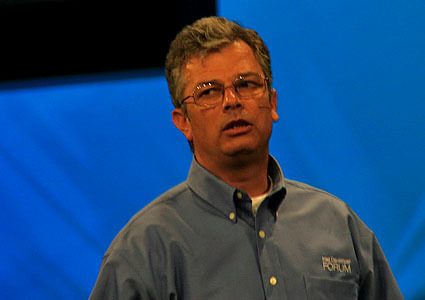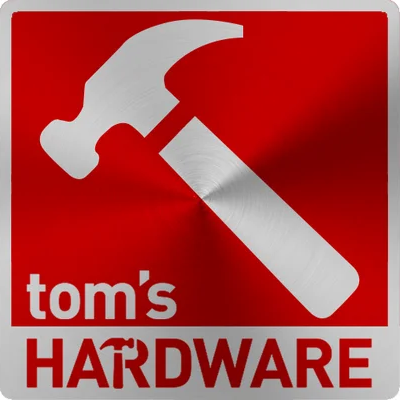TG Daily interviews Intel Senior VP: "Core is changing the game"
If you aren't excited about computers these days, you probably never will. Personally, I can't recall a time in which it was more intriguing to follow the events in the micro processor industry than today. The fact that AMD was able to sneak up on Intel and slap the giant left and right has brought us an unprecedented phase of innovation and value: I'd argue that there never has been more incentive to buy a new PC than later this year or in early 2007.
At TG Daily, we typically try to stay in touch with key players in the IT industry. Besides your everyday phone conversations and conversations at trade shows and conferences, we occasionally visit firms to talk about new trends and technologies. A few weeks ago, we visited Intel at its headquarter in Santa Clara, California, and got a chance to interview senior vice president David Perlmutter, who then shared the lead for Intel's Mobility Group with Sean Maloney.
Since then, Perlmutter has received sole responsibility for the business group that has developed the foundation for an architecture which could be considered the savior of Intel's microprocessor business: Core not only restores Intel's competitiveness, but it will also be the source for the lion's share of Intel's micro processor revenues over the next few years.
David Perlmutter
Perlmutter has not been a very public person so far and I welcomed the opportunity to learn more about his perspective on the microprocessor industry. Join me in a conversation about Core's potential, a sensible number of cores, power consumption trends, future architectures and products as well the importance of graphics. And don't forget to share your opinion on Perlmutter's answers with other readers in our forum.
TG Daily: The Core microarchitecture, most likely Intel's most important product in over a decade, is out of the gate. You have launched the Woodcrest Core as Xeon 5100 about a month ago; the mobile Merom and the desktop Conroe core are being introduced as Core 2 Duo. The question really is how they will stack up to AMD's processors. Somehow I feel you won't like this first question, because you probably have heard it many times: I'll ask it anyway: For the near future, how well will Core perform against AMD?
Perlmutter: I think we will fare very well. Assuming that AMD will come out with a new architecture in the second half of next year, it obviously will be tighter than today. We will be using a new process technology in 2007 that will allow us to keep the lead. Also, in the second half of 2008, we will be introducing a new micro architecture on 45 nm, Nehalem [as replacement of the Merom core family]. Overall, I think Core will do very well.
I actually like that question. I would have hated it two years ago. Today I am much more confident with predicting how well our product will do.
TG Daily: Would you go as far as saying that Core reverses the competitive landscape in the micro processor industry?
Perlmutter: Yes. I think Core is changing the game. That does not mean that I am underestimating the competition. I believe that they will do everything they can to be better than we are.
Get Tom's Hardware's best news and in-depth reviews, straight to your inbox.
TG Daily: In which way is it important for Intel that Merom is superior? Does it matter at this point?
Perlmutter: Well, I am a technologist. The nuances of the architecture and the performance are very important to me. In general, you always need technology leadership in order to be successful in the market place. And that leadership depends on two things: First, are you answering a need of you customers, depending on the market segment, and second, are you better or equal than your competition in this niche? I think these two factors are interrelated.
And, of course, there is also the question whether you are creating growth and a shift in the market place. Good products always create a shift in the market place. Mediocre products miss the growth of the market. For example, the Ipod and Centrino are products that really created a big change.
TG Daily: Several of our readers, some working for large corporations, have told us that they like the direction Intel is taking with Core. But they aren't completely convinced that you will deliver on your promises, for example on power efficiency. Do you think that Intel has lost some trust over the years with previous architectures and do you think that you can regain that trust?
| "Yes, you can see some skepticism in the market. To a certain degree, this has to do with the execution at Intel over the past years."David Perlmutter |
Perlmutter: Yes, you can see some skepticism in the market. To a certain degree, this has to do with the execution at Intel over the past years. And yes, I think we have to regain that trust. Regaining this trust by the way is something you have to do continuously and if it is something that has been used up, it is going to take a little longer. But I am ok with that.
I am looking at how we executed on our mobile technology in the last three years. We worked very much like clock work. I feel very confident about our ability of gaining back that trust.
But if you are coming back in six months with the same feedback, then something is not right and I would be concerned. It would mean that we haven't convinced the market about how great this product really is. We will have to be very precise in what we say and what we do.
TG Daily: AMD claims that its current and upcoming architectures will scale very well, especially in terms of power consumption and performance. They also claim that Core could be in scaling trouble very soon and put you in a 'Netburst trap'. So, from your view, how well will Core scale?
Perlmutter: Core scales and it will be scaling to the level we expect it to. That also applies to the upcoming generations - they all will come with the right scaling factors. But, of course, I would be lying if I said that it scales from here to eternity. In general, I believe that we will be able to do very well against what AMD will be able to do. I want everybody to go from a frequency world to a number-of-cores-world. But especially in the client space, we have to be very careful with overloading the market with a number of cores and see what is useful. I believe '2' is a good number. '4' will be an interesting number for the high-end. Will we see eight cores in the client in the next two years? If someone chooses to do that, engineering-wise that is possible. But I doubt this is something the market needs.
TG Daily: That basically means that you consider dual-cores as the sweetspot for now?
Perlmutter: Yes. You will start seeing four cores on the high-end and they will be going into the mainstream, but it will take a while. I think that it will be two or three years until you are going to see four cores entering the mainstream.
Tom's Hardware is the leading destination for hardcore computer enthusiasts. We cover everything from processors to 3D printers, single-board computers, SSDs and high-end gaming rigs, empowering readers to make the most of the tech they love, keep up on the latest developments and buy the right gear. Our staff has more than 100 years of combined experience covering news, solving tech problems and reviewing components and systems.


